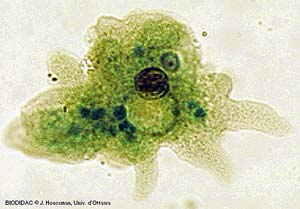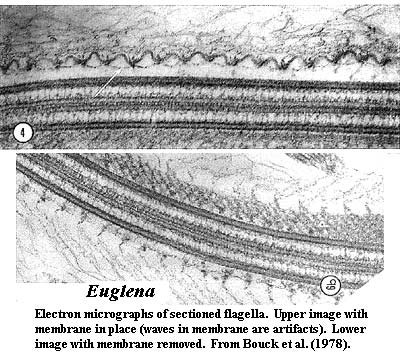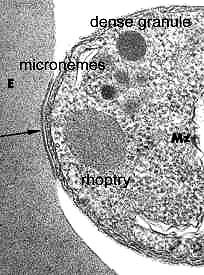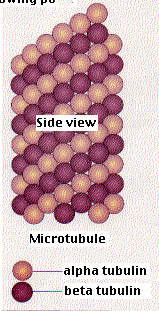
All material by ATW may be used under the terms of a
Public Domain Dedication.
| Glossary | ||
| Eukarya | Glossary L-O |
| Life | Time |

Ligand any chemical group attached to some molecule of interest.
Lobopodium a short, blunt, broad pseudopod typical of amoebae.
Lipid generally speaking, chemical-speak for fat. So far as we know, there are no really good, pithy definitions. See Lipids: Fats, Oils, Waxes, etc., among many good web pages on the subject.
LUCA Last Universal Common Ancestor. The last common ancestor of all extant species: Eubacteria, Archaea, and Eukarya.
Lutein a visual and photosynthetic pigment. See image at zeaxanthin.

Mastigoneme flagellar "hairs" found in the Chromista and Alveolata (= Chromalveolata). See image at right from Bouck et al. (1978). The mastigonemes of Euglena are unusually long. The mastigonemes probably function by flexing, so that the effective cross-sectional area of the flagellum is increased during the power stroke and reduced during the recovery stroke. Nakamura et al. (1996). Mastigonemes are composed largely of glycoproteins. Mastigonemes may be tubular or nontubular. Tubular and nontubular mastigonemes may be present on the same flagellum. Tubular mastigonemes are longer and rooted on the flagellar axoneme. [In fact they'd make a pretty good model for an intermediate state ending in the evolution of cilia from flagella.] The mastigonemes are arranged regularly-spaced clusters.
Mastigont same as kinetid. "In flagellates the mastigont system is usually a single unit comprised of the flagella with their basal bodies, the flagellar roots attached to the basal bodies, and the centrosomal structures associated with the basal bodies." Brugerolle 1991: 70).
Mastigiophore an anterior prolongation of the cell into which the flagellum inserts.
Mbp abbreviation for "million base pairs." A measure of gene or genome size in DNA base pairs.
Merogony a process that increases the number of infective cells. A single large schizont gives rise to a large number of small merozoites that infect other host cells.
Merozoite: a small, specialized, infective form of a parasitic eukaryotic species.
Merozont an intermediate form of cell produced during an early stage of replication, by merogony. The terms merozont, merozoont, meront, and meroblast are probably synonymous.

Microfiber, microfibril: not to be confused with microfilament. This is the generic term for intracellular fibers, whether or not composed of actin.
Microfilament Any of the minute actin fibers located throughout the cytoplasm of cells. See Microfilament Links.
Microneme electron-dense, convoluted tubular organelles forming part of the apical complex in in the Apicomplexa. Micronemes are often associated with, or give rise to, the rhoptries. Also called sarconeme. Apicomplexan parasites actively secrete proteins at their apical pole as part of the host cell invasion process in response to free Ca++ in the parasite's cytoplasm. The adhesive micronemal proteins are involved in the recognition of host cell receptors. Redistribution of these receptor-ligand complexes toward the posterior pole of the parasites is powered by the actinomyosin system of the parasite and is presumed to drive parasite gliding motility and host cell penetration. Carruthers & Sibley (1999); Lovett et al. (2002).

Microtubule Microtubules are protein structures found within cells. They are generally long and form a structural network (the cytoskeleton) within the cell's cytoplasm, but in addition to structural support microtubules are used in many other processes as well. They form a substrate on which other cellular chemicals can interact, they are used in intracellular transport, and are involved in cell motility. The assembly and disassembly of microtubules into their subcomponent tubulin is one way in which cells can change their shape. A notable structure involving microtubules is the mitotic spindle used by eukaryotic cells to segregate their chromosomes correctly during cell division. Microtubules are also responsible for the flagella of eukaryotic cells (prokaryote flagella are entirely different). From Microtubule - Wikipedia; see also, Structure and Function of Microtubules. Microtubules are straight, hollow cylinders have a diameter of about 25 nm are variable in length but can grow 1000 times as long as they are thick. Microtubules are built by the assembly of dimers of alpha tubulin and beta tubulin. Microtubules grow at each end by the polymerization of tubulin dimers (powered by the hydrolysis of GTP), and shrink at each end by the release of tubulin dimers (depolymerization). However, both processes always occur more rapidly at one end, called the plus end. The other, less active, end is the minus end. Microtubules participate in a wide variety of cell activities. Most involve motion. The motion is provided by protein "motors" that use the energy of ATP to move along the microtubule. From The Cytoskeleton.
Mitochondrion: an organelle responsible for most of the oxidative metabolism in the cell. There is far too much to cover in a glossary definition. See Mitochondrion - Wikipedia for a relatively brief introduction.
Monophyletic a taxon is said to be monophyletic if (a) it includes the last common ancestor of all members of the group and (b) it includes all descendants of that last common ancestor.
mRNA RNA species which enter the cytoplasm, are bound by ribosomes and used as templates to produce proteins (in the process known as translation). Fully processed mRNA bears a peculiar reversed-nucleotide 5'-cap and a series of adenine nucleotides at the opposite, 3', end. All non-coding introns have been spliced out. Thus, mRNA consists, except for the 5' and 3' terminal sequences, of an unbroken series of nucleotide bases in the triplet genetic code for amino acids.
Myzocytosis cellular vampirism. A method of feeding in which a predatory cell pierces the wall (if present) and membranes of a prey cell and sucks out the contents.
Open mitosis In closed mitosis, the nuclear envelope remains intact and chromosomes migrate to opposite poles of a spindle formed by centrioles within the nucleus. In open mitosis, the nuclear envelope breaks down and then re-forms around the two sets of separated chromosomes. Closed and open mitosis.
Osmotic pressure Most biological membranes are impermeable to many of the solutes found in the cell. If this were not so, all of the valuable biomolecules in the cell would simply diffuse out and be lost. However, the same membranes are often more or less permeable to water. Since there are many solutes trapped in the cell, the "concentration" of water is lower in the cell than outside, i.e., there are more water molecules per unit volume outside the cell than inside. Diffusion of water through the membrane works both ways and is completely random. However, water "concentration" is higher outside the cell. That is, there are more water molecules in contact with the membrane on the outside than on the inside. So, there will be a net flux of water into the cytoplasm until the concentrations equalize. The osmotic potential is the measure of the net tendency of water to enter the cell. Real cells can't usually behave in this fashion, since the cell will expand and ultimately burst. The problem is handled in numerous different ways, depending on the cell type. In plant cells (and various others), the cell membrane is confined within a semi-rigid cell wall. Water enters the cell only until the elastic reaction force of the cell wall equals the outward force caused by water molecules crowding into the cell. At steady state, the plant cell then maintains a rather high internal pressure, referred to as turgor pressure. Turgor pressure serves as a sort of internal hydrostatic skeleton which helps to support -- and even move -- the plant structures.